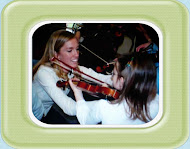
The Suzuki Method was developed by Dr. Shinichi Suzuki of Japan in the mid-1900s. Since its development, it has become one of the most popular musical teaching philosophies and curriculum in the world. Suzuki founded the method after he observed young children and the fact that all children around the world learn to speak a regional dialect when they are very young. He concluded that this exceptional ability to speak fluently at such a young age is because of the environment in which the child is surrounded. He observed that all children listen to the voices of their mother from the time they are in the womb. This constant emersion in dialogue allows a child to copy what he hears at an early age. Dr. Suzuki took this method- which he named the mother-tongue approach- and applied it to music. He believed that all young children, whose ears are constantly absorbing every sound around them, can learn a musical instrument as long as their environment permits them to do so.
Creating the environment that permits easy learning for young children involves several different components. These components include the following: Parent Involvement, Daily Listening, and Reviewing Repertoire.
The philosophy of the Suzuki Method is centered around the belief that every child can learn a musical instrument. Dr. Suzuki’s goal in creating the Suzuki method was to create a noble soul and a pure heart. Ideally, each Suzuki teacher strives to create not only exceptional talent, but a beautiful character in her students as well. This is achieved through a nurturing and loving environment.
To learn more about Dr. Shinichi Suzuki and the Suzuki Method, please read “Nurtured by Love”
Creating the environment that permits easy learning for young children involves several different components. These components include the following: Parent Involvement, Daily Listening, and Reviewing Repertoire.
The philosophy of the Suzuki Method is centered around the belief that every child can learn a musical instrument. Dr. Suzuki’s goal in creating the Suzuki method was to create a noble soul and a pure heart. Ideally, each Suzuki teacher strives to create not only exceptional talent, but a beautiful character in her students as well. This is achieved through a nurturing and loving environment.
To learn more about Dr. Shinichi Suzuki and the Suzuki Method, please read “Nurtured by Love”


